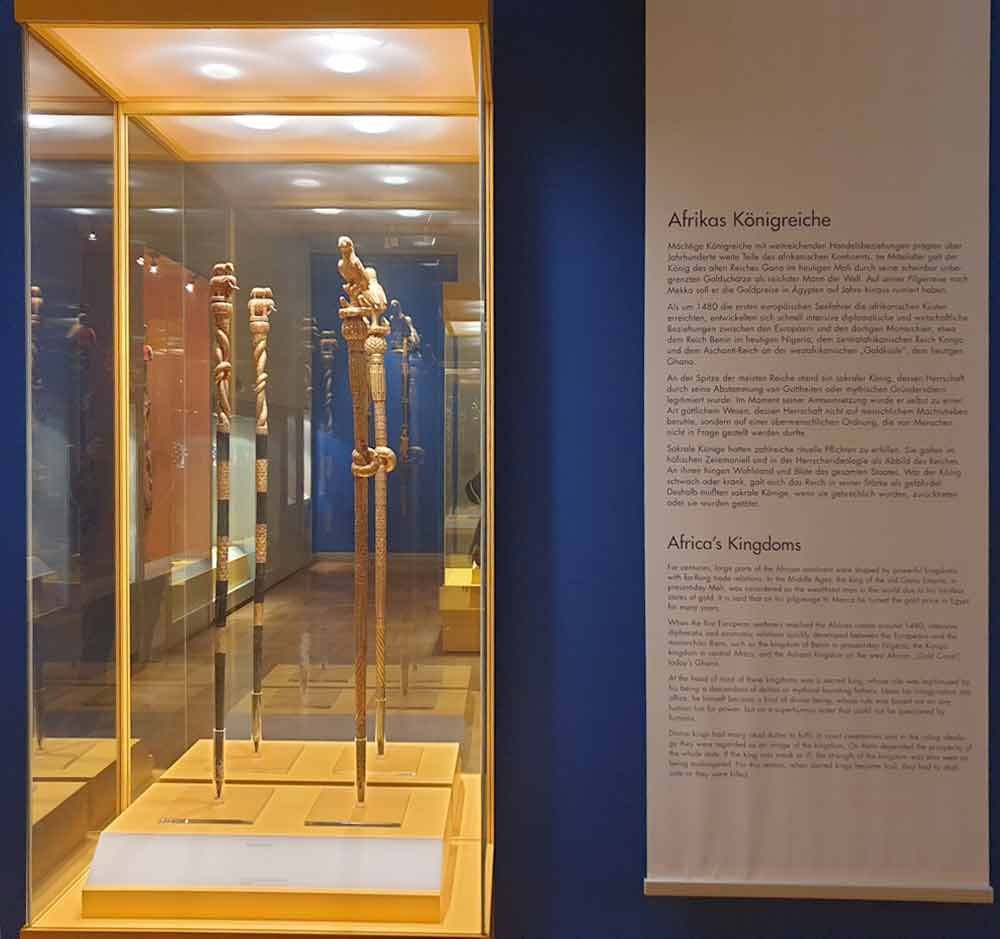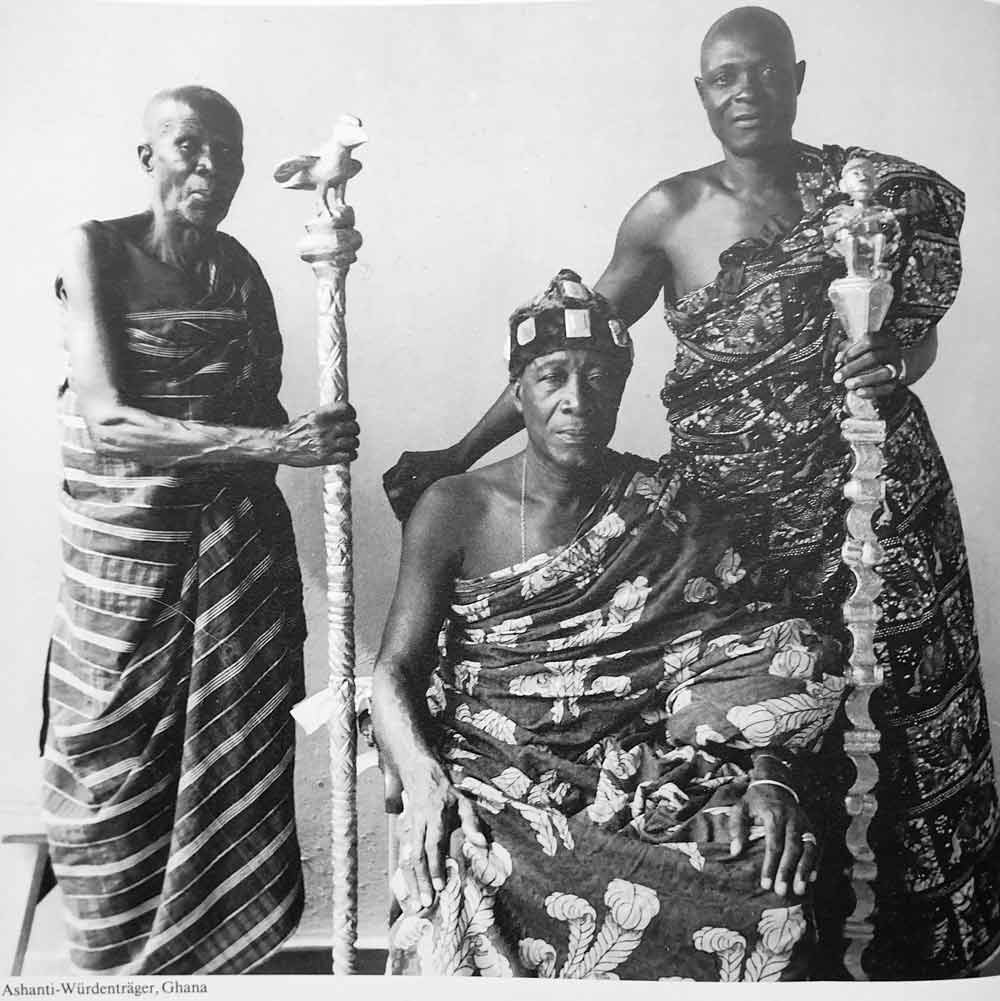The Akan linguist1 staff icon represents various aspects of the philosophy, values and symbolism of clan, town or ethnicity. The elephant icon, like other symbols of the Asante empire, is used in fabric and stool designs as well as the finial of the staff (Sarpong (1971:24), which is an important group formal identity symbol. Users of the staff include storytellers, clan linguists, and, most characteristically state linguists. Yankah has this to say about the state linguist staff:
“Every Akan chief or king has two or more staffs. The higher a chief’s status the wider the range of staffs, since and important chief deals with a greater variety of social and political situations and has to match various situations with relevant messages (1995: 33).”
The meaning and artistic significance of the finial of the linguist staff may be seen by considering the choice and artistic design of the finial, the identity of the user, and finally, the context in which the staff is used. The identity of the user, in this context, is the linguist of the King of Ashanti, a very powerful Akan monarch, whose influence and control is acknowledged over centuries and across different parts of Ghana.
The paper examines the motivations for the choice and representation of the Elephant-Calf symbol, and the overall cultural and social significance of the use of this symbol.
The Symbol in Context
Two aspects of the image might are important for our current discussion: the finial itself, and the upper shaft on which sits the base carrying the finial. The upper shaft consists of two veiny lines which with a wisdom knot in their middle. The next is the finial – Mother Elephant with its Calf Standing on it.
The choice of the elephant is based on the preeminence of the elephant as an animal. The elephant is universally used as a royal symbol of power and strength, and among the Akan of Ghana, Kwarteng (2006) reports that the paramount chiefs of Denkyira, Eguafo, Abura, Ajumako, Abeaze, Offinso, Wassa Amenfi have elephants as their royal symbol. The elephant is called ‘sono’ in Akan, and the morphological connection between the name and the Akan expression for immensity ‘so’ seems to emphasize the natural immensity of the elephant, which is also be expressed in the following:
‘Ɔson akyi nni aboa.’
(There is no animal beyond the elephant).
The leadership and protection associated with the elephant is represented in the saying:
'Wodi esono akyi a hasuo nya wo. '
(When you follow the elephant you are safe from the early morning dew of the bush)
The Akan see the immensity of the elephant from the social, political and spiritual perspective also. Socially, the flesh of the elephant is socially significant as it, unlike all other animals, provides meat for the whole community for an extended period. Politically, its parts, skin, ears and tusks are crucial aspects of the insignia of royalty. Again, spiritually, among animals, the elephant is seen to have the greatest ‘sasa’, a kind of spiritual force normally associated with humans. The ‘sasa’ is a spirit which protects its possessor through life and which assails its killers after its death. Sekyi-Baidoo (1994) reports of extensive activities for preventing the ‘sasa’ of the elephant from escaping from the carcass to assail its killer. Overall, the elephant stands for physical, spiritual and social preeminence among the Akan.
The Representation
The Upper Shaft
According some traditional consultants, the veiny lines, as seen above, represent the demands of the governance of the empire, which are controlled by the knot, symbolising the cohesion, control and direction of the Asantehene.
The Parent Elephant
The finial representation captures the side view of the elephant, showing major aspects of its immensity and power - the body, which showcases its immense size, the heavy legs, showing its matchless stability, strength and force; the trunk, with which it breathes, smells, grasps and lifts objects and produces sound; and the tusk, with which it digs, lifts, gathers, attacks and defends itself. The limbs and the trunk are presented in neutral posture: both feet firm on the ground and the trunk lowered – not picking anything nor blurting - suggesting placidity. On the other hand, the tusks, bigger than natural, are lifted, pointing to an ever-readiness - not to attack, but to defend. It is on this placid but defence-ready image of the elephant that the dependant calf is placed - for optimal comfort and security. It is explained that this image symbolizes the prosperous relationship between the Asantehene and the people over whom he rules - not intimidating them with his supreme power and authority, but ensuring their peace and security.
The Calf
Interestingly, unlike the elephant, the calf is presented panoramically - without the details of ears, tusk and trunk - its source of perception, control, nourishment and defence, for which it would depend on the mother. This is understood to symbolise the governance relationship in the Ashanti Kingdom where the subjects look to the Asantehene for intelligence, protection and support.
According to traditional informants, the elephant-calf image is sometimes interpreted as symbolizing the permanence of the supremacy of the Ashanti Empire - from 1701 to present – perhaps, unlike others powers which rise and fall.

Significance
As intimated above, beyond its art and royal attraction, the elephant-calf image of the Ashanti royalty reflects ethnic and universal ideals of effective leadership, which is for cohesion and protection and, rather than for oppression. This is evident in the symbol of the wisdom knot and the image of the elephant carrying the calf. This education on the effective use of power is relevant to majority/minority and local as well as international rich/poor contexts. On the reverse, it also points to the Akan and universal idea of responsible followership - submission and trust, and is easily utilised for the education of children. The image, thus, represents an effective blend of governance, culture and education.

References
- Kwarteng, K. O. (2006). The elephant in pre-colonial Ghana: Cultural and economic use values. Journal of Philosophy and Culture, Vol. 3 (2) June 2006: 1 -32.
- Sarpong, P. (1971). The sacred stools of the Akan. Accra: Ghana Publishing.
- Sekyi-Baidoo, J. Y. (1994) The Aesthetic and cosmological features of the Akan hunters’ song. MPhil Dissertation, Institute of African Studies, University of Ghana, Legon
- Yankah, K. (1995). Speaking for the chief: Ȯkyeame and the politics of Akan royal oratory. Bloomington & Indianapolis: Indiana University Press.
Footnote:
1) The term „linguist“ has been adopted in Ghana for the Akan designation „Okyeame“ in an attempt to find an English equivalent for the role of the chief´s or king´s diplomacy attendant. This may have arisen out of the acknowledgement of the linguistic capabilities displayed by the attendants, whose main resource was language.
published January 2021
This article is part of a gallery: Perspectives from Ghana on Museum Objects in Germany



